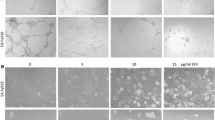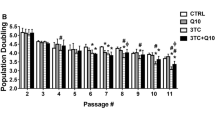Abstract
HIV-1 infection is associated with serious cardiovascular complications, but the roles of HIV-1, viral proteins, and highly active antiretroviral therapy (HAART) drugs are not understood. HAART decreases the overall risk of heart disease but leads to metabolic disturbances and possibly coronary artery disease. We investigated toxicities of HIV-1, HIV-1 glycoprotein 120 (gp 120), and HAART drugs for human coronary artery endothelial cells (CAECs), brain microvascular endothelial cells, and neonatal rat ventricular myocytes (NRVMs). HIV-1 and gp 120, but not azidothymidine (AZT), induced apoptosis of NRVMs and CAECs. Ethylisothiourea, an inhibitor of nitric oxide synthase, inhibited apoptosis induction by gp 120. AZT, HIV-1, and gp 120 all damaged mitochondria of cardiomyocytes. HAART drugs, AZT, and indinavir, but not HIV-1, produced intercellular gaps between confluent endothelial cells and decreased transendothelial electrical resistance. In conclusion, HIV-1 and gp 120 induce toxicity through induction of cardiomyocyte and endothelial cell apoptosis. HAART drugs disrupt endothelial cell junctions and mitochondria and could cause vascular damage.
Similar content being viewed by others
References
Lewis, W. (2000). Cardiomyopathy in AIDS: a pathophysiological perspective. Prog. Cardiovasc. Dis. 43:151–170.
Koppel, K., Bratt, G., Eriksson, M., and Sandstrom, E. (2000). Serum lipid levels associated with increased risk for cardiovascular disease is associated with highly active antiretroviral therapy (HAART) in HIV-1 infection. Int. J. STD AIDS 11:451–455.
Barbaro, G. (2002). Cardiovascular manifestations of HIV infection. Circulation 106:1420–1425.
Liu, Q.N., Reddy, S., Sayre, J.W., Pop, V., Graves, M.C., and Fiala, M. (2001). Essential role of HIV type 1-infected and cyclooxygenase 2-activated macrophages and T cells in HIV type 1 myocarditis. AIDS Res. Hum. Retroviruses 17:1423–1433.
Barbaro, G., Di Lorenzo, G., Grisorio, B., and Barbarini, G. (1998). Cardiac involvement in the acquired immunodeficiency syndrome: a multicenter clinical-pathological study. Gruppo Italiano per lo Studio Cardiologico dei pazienti affetti da AIDS Investigators. AIDS Res. Hum. Retroviruses 14:1071–1077.
Stein, J.H., Klein, M.A., Bellehumeur, J.L., McBride, P.E., Wiebe, D.A., Otvos, J.D., et al. (2001). Use of human immunodeficiency virus-1 protease inhibitors is associated with atherogenic lipoprotein changes and endothelial dysfunction. Circulation 104:257–262.
Periard, D., Telenti, A., Sudre, P., Cheseaux, J.J., Halfon, P., Reymond, M.J., et al. (1999). Atherogenic dyslipidemia in HIV-infected individuals treated with protease inhibitors. The Swiss HIV Cohort Study. Circulation 100:700–705.
Twu, C., Liu, N.Q., Popik, W., Bukrinsky, M., Sayre, J., Roberts, J., et al. (2002). Cardiomyocytes undergo apoptosis in human immunodeficiency virus cardiomyopathy through mitochondrion- and death receptor-controlled pathways. Proc. Natl. Acad. Sci. USA 99:14386–14391.
Cicala, C., Arthos, J., Selig, S.M., Dennis, G. Jr., Hosack, D.A., Van Ryk, D., et al. (2002). HIV envelope induces a cascade of cell signals in non-proliferating target cells that favor virus replications. Proc. Natl. Acad. Sci. USA 99:9380–9385.
Izmailova, E., Bertley, F.M., Huang, Q., Makori, N., Miller, C.J., Young, R.A., et al. (2003). HIV-1 tat reprograms immature dendritic cells to express chemoattractants for activated T cells and macrophages. Nat. Med. 9:191–197.
Chen, D., Wang, M., Zhou, S., and Zhou, Q. (2002). HIV-1 Tat targets microtubules to induce apoptosis, a process promoted by the pro-apoptotic Bcl-2 relative Bim. EMBO J. 21:6801–6810.
Kinter, A.L., Umscheid, C.A., Arthos, J., Cicala, C., Lin, Y., Jackson, R., et al. (2003). HIV envelope induces virus expression from resting CD4+ T cells isolated from HIV-infected individuals in the absence of markers of cellular activation or apoptosis. J. Immunol. 170:2449–2455.
Tobiume, M., Fujinaga, K., Suzuki, S., Komoto, S., Mukai, T., and Ikuta, K. (2002). Extracellular Nef protein activates signal transduction pathway from Ras to mitogen-activated protein kinase cascades that leads to activation of human immunodeficiency virus from latency. AIDS Res. Hum. Retroviruses 18:461–467.
Carr, A. and Cooper, D.A. (2000). Adverse effects of antiretroviral therapy. Lancet 356:1423–1430.
Reid, W., Sadowska, M., Denaro, F., Rao, S., Foulke, J. Jr., Hayes, N., et al. (2001). An HIV-1 transgenic rat that develops HIV-related pathology and immunologic dysfunction. Proc. Natl. Acad. Sci. USA 98:9271–9276.
Kay, D.G., Yue, P., Hanna, Z., Jothy, S., Tremblay, E., and Jolicoeur, P. (2002). Cardiac disease in transgenic mice expressing human immunodeficiency virus-1 nef in cells of the immune system. Am. J. Pathol. 161:321–335.
Raidel, S.M., Haase, C., Jansen, N.R., Russ, R.B., Sutliff, R.L., Velsor, L.W., et al. (2002). Targeted myocardial transgenic expression of HIV Tat causes cardiomyopathy and mitochondrial damage. Am. J. Physiol. Heart Circ. Physiol. 282:H1672–1678.
Lewis, W., Simpson, J.F., and Meyer, R.R. (1994). Cardiac mitochondrial DNA polymerase-gamma is inhibited competitively and noncompetitively by phosphorylated zidovudine. Circ. Res. 74:344–348.
Dalakas, M.C., Illa, I., Pezeshkpour, G.H., Laukaitis, J.P., Cohen, B., and Griffin, J.L. (1990). Mitochondrial myopathy caused by long-term zidovudine therapy. N. Engl. J. Med. 322:1098–1105.
Lipshultz, S.E., Easley, K.A., Orav, E.J., Kaplan, S., Starc, T.J., Bricker, J.T., et al. (2000). Absence of cardiac toxicity of zidovudine in infants: pediatric pulmonary and cardiac complications of vertically transmitted HIV infection study group. N. Engl. J. Med. 343:759–766.
Bozzette, S.A., Ake, C.F., Tam, H.K., Chang, S.W., and Louis, T.A. (2003). Cardiovaccular and cerebrovascular events in patients treated for human immunodeficiency virus infection. N. Engl. J. Med. 348:702–710.
Moyle, G. and Carr, A. (2002). HIV-associated lipodystrophy metabolic complications, and antiretroviral toxicities. HIV Clin. Trials 3:89–98.
Barbaro, G., Di Lorenzo, G., Cirelli, A., Grisorio, B., Lucchini, A., Hazra, C., et al. (2003). An open-label, prospective, observational study of the incidence of coronary artery disease in patients with HIV infection receiving highly active antiretroviral therapy. Clin. Ther. 25:2405–2418.
Oh, S.K., Cruikshank, W.W., Raina, J., Blanchard, G.C., Adler, W.H., Walker, J., et al. (1992). Identification of HIV-1 envelope glycoprotein in the serum of AIDS and ARC patients. J. Acquir. Immune Defic. Syndr. 5:251–256.
Mossman, S.P., Bex, F., Berglund, P., Arthos, J., O'Neil, S.P., Riley, D., et al. (1996). Protection against lethal simian immunodeficiency virus SIV smmPBj14 disease by a recombinant Semliki Forest virus gp 160 vaccine and by a gp 120 subunit vaccine. J. Virol. 70:1953–1960.
Liu, N.Q., Lossinsky, A.S., Popik, W., Li, X., Gujuluva, C., Kriederman, B., et al. (2002). Human immunodeficiency virus type 1 enters brain microvascular endothelia by macropinocytosis dependent on lipid rafts and the mitogen-activated protein kinase, signaling pathway. J. Virol. 76:6689–6700.
Gujuluva, C., Burns, A.R., Pushkarsky, T., Popik, W., Berger, O., Bukrinsky, M., et al. (2001). HIV-1 penetrates coronary artery endothelial cells by transcytosis. Mol. Med. 7:169–176.
Garcia, J.G., Schaphorst, K.L., Verin, A.D., Vepa, S., Patterson, C.E., and Natarajan, V. (2000). Diperoxovanadate alters endothelial cell focal contacts and barrier function: role of tyrosine phosphorylation. J. Appl. Physiol. 89:2333–2343.
Carr, A. (2000). HIV protease inhibitor-related lipodystrophy syndrome. Clin. Infect. Dis. 30(Suppl. 2):S135-S142.
Cioffi, D.L., Moore, T.M., Schaack, J., Creighton, J.R., Cooper, D.M., and Stevens, T. (2002). Dominant regulation of interendothelial cell gap formation by calcium-inhibited type 6 adenylyl cyclase. J. Cell Biol. 157:1267–1278.
Bogatcheva, N.V., Garcia, J.G., and Verin, A.D. (2002). Molecular mechanisms of thrombin-induced endothelial cell permeability. Biochemistry (Mosc.) 67:75–84.
Wojciak-Stothard, B., Potempa, S., Eichholtz, T., and Ridley, A.J. (2001). Rho and Rac but not Cdc42 regulate endothelial cell permeability. J. Cell Sci. 114:1343–1355.
Sandoval, R., Malik, A.B., Minshall, R.D., Kouklis, P., Ellis, C.A., and Tiruppathi, C. (2001). Ca(2+) signalling and PKC alpha activate increased endothelial permeability by disassembly of VE-cadherin junctions. J. Physiol. 533:433–445.
Borbiev, T., Garcia, J., and Verin, A.D. (2003). Role of phosphorylation of myosin- and actin-binding proteins in thrombin-induced permeability of endothelial cells. Russ. J. Bioorganic Chem. 29:464–470.
Shi, S., Verin, A.D., Schaphorst, K.L., Gilbert-McClain, L.I., Patterson, C.E., Irwin, R.P., et al. (1998). Role of tyrosine phosphorylation in thrombin-induced endothelial cell contraction and barrier function. Endothelium 6:153–171.
Lewis, W., Haase, C.P., Raidel, S.M., Russ, R.B., Sutliff, R.L., Hoit, B.D., et al. (2001). Combined antiretroviral therapy causes cardiomyopathy and elevates plasma lactate in transgenic AIDS mice. Lab. Invest. 81:1527–1536.
Narula, J., Haider, N., Virmani, R., DiSalvo, T.G., Kolodgie, F.D., Hajjar, R.J., et al. (1996). Apoptosis in myocytes in end-stage heart failure. N. Engl. J. Med. 335:1182–1189.
Barbaro, G., Di Lorenzo, G., Soldini, M., Giancaspro, G., Grisorio, B., Pellicelli, A., et al. (1999). Intensity of myocardial expression of inducible nitric oxide synthase influences the clinical course of human immunodeficiency virus-associated cardiomyopathy. Gruppo Italiano per lo Studio Cardiologico dei pazienti affetti da AIDS (GISCA). Circulation 100:933–939.
Kroncke, K.D., Fehsel, K., Suschek, C., and Kolb-Bachofen, V. (2001). Inducible nitric oxide synthase-derived nitric oxide in gene regulation, cell death and cell survival. Int. Immunopharmacol. 1:1407–1420.
Kan, H., Xie, Z., and Finkel, M.S. (2000). HIV gp 120 enhances NO production by cardiac myocytes through p38 MAP kinase-mediated NF-kappaB activation. Am. J. Physiol. 279:H3138–3143.
Author information
Authors and Affiliations
Corresponding author
Rights and permissions
About this article
Cite this article
Fiala, M., Murphy, T., MacDougall, J. et al. HAART drugs induce mitochondrial damage and intercellular gaps and gp 120 causes apoptosis. Cardiovasc Toxicol 4, 327–337 (2004). https://doi.org/10.1385/CT:4:4:327
Received:
Revised:
Accepted:
Issue Date:
DOI: https://doi.org/10.1385/CT:4:4:327




